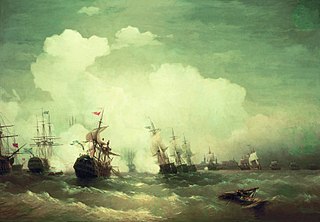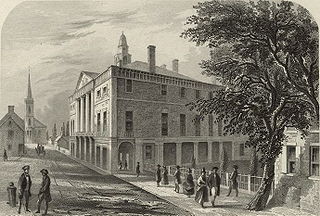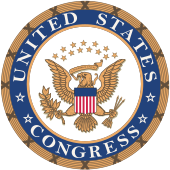
1790 (MDCCXC) was a common year starting on Friday of the Gregorian calendar and a common year starting on Tuesday of the Julian calendar, the 1790th year of the Common Era (CE) and Anno Domini (AD) designations, the 790th year of the 2nd millennium, the 90th year of the 18th century, and the 1st year of the 1790s decade. As of the start of 1790, the Gregorian calendar was 11 days ahead of the Julian calendar, which remained in localized use until 1923.

Alexander Hamilton was an American military officer, statesman, and Founding Father who served as the first secretary of the treasury from 1789 to 1795 during George Washington's presidency.

The President, Directors and Company of the Bank of the United States, commonly known as the First Bank of the United States, was a national bank, chartered for a term of twenty years, by the United States Congress on February 25, 1791. It followed the Bank of North America, the nation's first de facto national bank. However, neither served the functions of a modern central bank: They did not set monetary policy, regulate private banks, hold their excess reserves, or act as a lender of last resort. They were national insofar as they were allowed to have branches in multiple states and lend money to the US government. Other banks in the US were each chartered by, and only allowed to have branches in, a single state.

The 1st United States Congress, comprising the United States Senate and the United States House of Representatives, met from March 4, 1789, to March 4, 1791, during the first two years of George Washington's presidency, first at Federal Hall in New York City and later at Congress Hall in Philadelphia. With the initial meeting of the First Congress, the United States federal government officially began operations under the new frame of government established by the 1787 Constitution. The apportionment of seats in the House of Representatives was based on the provisions of Article I, Section 2, Clause 3, of the Constitution. Both chambers had a Pro-Administration majority. Twelve articles of amendment to the Constitution were passed by this Congress and sent to the states for ratification; the ten ratified as additions to the Constitution on December 15, 1791, are collectively known as the Bill of Rights, with an additional amendment ratified more than two centuries later to become the Twenty-seventh Amendment to the United States Constitution.

Robert Morris Jr. was an English-American merchant and a Founding Father of the United States. He served as a member of the Pennsylvania legislature, the Second Continental Congress, and the United States Senate, and he was a signer of the Declaration of Independence, the Articles of Confederation, and the United States Constitution. From 1781 to 1784, he served as the Superintendent of Finance of the United States, becoming known as the "Financier of the Revolution." Along with Alexander Hamilton and Albert Gallatin, he is widely regarded as one of the founders of the financial system of the United States.

The history of the United States from 1789 to 1815 was marked by the nascent years of the American Republic under the new U.S. Constitution.

In United States history, the Hamiltonian economic program was the set of measures that were proposed by American Founding Father and first Secretary of the Treasury Alexander Hamilton in four notable reports and implemented by Congress during George Washington's first term. They outlined a coherent program of national mercantilism government-assisted economic development.
The Anti-Administration party was an informal political faction in the United States led by James Madison and Thomas Jefferson that opposed policies of then Secretary of the Treasury Alexander Hamilton in the first term of U.S. president George Washington. It was not an organized political party, but an unorganized faction. Most members had been Anti-Federalists in 1788, when they opposed ratification of the U.S. Constitution. However, the situation was fluid, with members joining and leaving.
Tariffs have historically served a key role in the trade policy of the United States. Their purpose was to generate revenue for the federal government and to allow for import substitution industrialization by acting as a protective barrier around infant industries. They also aimed to reduce the trade deficit and the pressure of foreign competition. Tariffs were one of the pillars of the American System that allowed the rapid development and industrialization of the United States. The United States pursued a protectionist policy from the beginning of the 19th century until the middle of the 20th century. Between 1861 and 1933, they had one of the highest average tariff rates on manufactured imports in the world. However American agricultural and industrial goods were cheaper than rival products and the tariff had an impact primarily on wool products. After 1942 the U.S. began to promote worldwide free trade, but after the 2016 presidential election has gone back to protectionism.
The Compromise of 1790 was a compromise among Alexander Hamilton, Thomas Jefferson, and James Madison, where Hamilton won the decision for the national government to take over and pay the state debts, and Jefferson and Madison obtained the national capital, called the District of Columbia, for the South. This agreement resolved the deadlock in Congress. Southerners had been blocking the assumption of state debts by the Department of the Treasury, thereby destroying the Hamiltonian program for building a fiscally strong federal government. Northerners rejected the proposal, much desired by Southerners, to locate the permanent national capital on the Virginia–Maryland border.

The First Report on the Public Credit was one of four major reports on fiscal and economic policy submitted by Founding Father and first US Treasury Secretary Alexander Hamilton on the request of Congress. The report analyzed the financial standing of the United States and made recommendations to reorganize the national debt and to establish the public credit. Commissioned by the US House of Representatives on September 21, 1789, the report was presented on January 9, 1790, at the second session of the 1st US Congress.

The presidency of George Washington began on April 30, 1789, when Washington was inaugurated as the first president of the United States, and ended on March 4, 1797. Washington took office after the 1788–1789 presidential election, the nation's first quadrennial presidential election, in which he was elected unanimously by the Electoral College. Washington was re-elected unanimously in the 1792 presidential election and chose to retire after two terms. He was succeeded by his vice president, John Adams of the Federalist Party.
In United States history, the Second Report on the Public Credit, also referred to as The Report on a National Bank, was the second of four influential reports on fiscal and economic policy delivered to Congress by the first U.S. Secretary of the Treasury, Alexander Hamilton. Submitted on December 14, 1790, the report called for the establishment of a central bank with the primary purpose to expand the flow of legal tender, monetizing the national debt by issuing of federal bank notes.

The Federalist Era in American history ran from 1788 to 1800, a time when the Federalist Party and its predecessors were dominant in American politics. During this period, Federalists generally controlled Congress and enjoyed the support of President George Washington and President John Adams. The era saw the creation of a new, stronger federal government under the United States Constitution, a deepening of support for nationalism, and diminished fears of tyranny by a central government. The era began with the ratification of the United States Constitution and ended with the Democratic-Republican Party's victory in the 1800 elections.

John Jay was an American statesman, diplomat, abolitionist, signatory of the Treaty of Paris, and a Founding Father of the United States. He served from 1789 to 1795 as the first chief justice of the United States and from 1795 to 1801 as the second governor of New York. Jay directed U.S. foreign policy for much of the 1780s and was an important leader of the Federalist Party after the ratification of the United States Constitution in 1788.
The Funding Act of 1790, the full title of which is An Act making provision for the [payment of the] Debt of the United States, was passed on August 4, 1790, by the United States Congress as part of the Compromise of 1790, to address the issue of funding of the domestic debt incurred by the state governments, first as Thirteen Colonies, then as states in rebellion, in independence, in Confederation, and finally as members of a single federal Union. By the Act, the newly-inaugurated federal government under the U.S. Constitution assumed and thereby retired the debts of each of the individual colonies in rebellion and the bonded debts of the States in Confederation, which each state had individually and independently issued on its own "full faith and credit" when each of them was, in effect, an independent nation.

The Bank Bill of 1791 is a common term for two bills passed by the First Congress of the United States of America on February 25 and March 2 of 1791.

Tariff of 1791 or Excise Whiskey Tax of 1791 was a United States statute establishing a taxation policy to further reduce Colonial America public debt as assumed by the residuals of American Revolution. The Act of Congress imposed duties or tariffs on domestic and imported distilled spirits generating government revenue while fortifying the Federalist Era.
The presidency of George Washington began on April 30, 1789, when George Washington was inaugurated as the first president of the United States, and ended on March 4, 1797.

Copper Coinage Act of 1792 is a United States statute authorizing copper coinage to be engraved and issued by the United States Mint. The Act of Congress confirmed the procurement of copper not to exceed a weight of 150 short tons (300,000 lb). The United States Mint procured a shipment of copper at a weight of 15 short tons (30,000 lb) as endorsed by the first director of the mint David Rittenhouse.












